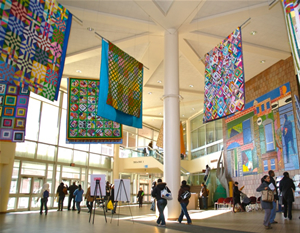
More high academic achievers with top-tier grades and highly competitive SAT scores are choosing the colleges of The City University of New York.
Five elite New York City public high schools – Bronx High School of Science, Brooklyn Technical High School, Staten Island Technical High School, Stuyvesant High School and Townsend Harris High School – sent 505 freshmen to CUNY colleges this fall, a 27 percent increase compared with the number enrolled in baccalaureate programs in 1999.
Moreover, CUNY colleges attracted 166 percent more first-time freshmen with combined math-verbal SAT scores of 1200 or higher — 1,487 such students compared to 559 in 1999. And since 1999, the colleges have more than doubled their enrollment of first-time freshmen with high-school averages of 85 or better, according to University data on the new freshman classes.
The resounding vote of confidence from high academic achievers is even outpacing the University record enrollment growth on a percentage basis. CUNY’s fall 2008 enrollment is at 242,898, up 4.3 percent from fall 2007, when 232,960 students matriculated. This is the ninth consecutive year of enrollment gains. More students are seeking degrees and studying at campuses across the five boroughs than at any time since the mid 1970s.
“In difficult economic times, students and their families especially appreciate the high value of an education at a CUNY college,” said Chancellor Matthew Goldstein. “We are investing in CUNY by attracting world class faculty, building modern facilities and creating innovative academic programs in the most exciting city in the world. The University today is among the best values in higher education.”
Other notable enrollment trends this fall include increases in both full- and part-time study at the undergraduate and graduate levels; in professional training and in degree programs that offer flexible modes of learning.
Beyond the traditional, fall-spring semester model, the University promoted a feast of “Summer in the City” classes and activities this past summer – yielding a 4.8 percent enrollment increase over the summer of 2007. CUNY is also gearing up for Winter Session ’09. The shorter sessions are quick, intensive opportunities to earn academic credits, and are expected to boost year-round enrollments even more by exposing CUNY and non-CUNY students to the University and its affordable offerings.
The fall 2008 enrollment data show the University building upon a wave of student increases that began in 2000, when CUNY implemented administrative and academic reforms that have boosted its reputation nationwide.
In addition to the outstanding new faculty teaching at CUNY this fall, the University continues to strengthen its science programs in part by expanding Ph.D.-granting authority to two science-focused senior colleges, City and Hunter; by modernizing science facilities in all five boroughs, and it has hewed to its mission to expand educational opportunities for one of the most diverse student populations in the world.
This fall, every CUNY sector, from senior colleges to community colleges to graduate programs, posted notable enrollment increases compared with fall 2007.
CUNY’s community colleges saw the largest gains overall, 5.9 percent, with Borough of Manhattan Community College in the vanguard with a 10.9 percent increase, followed by Kingsborough, 7.7 percent, and Queensborough, 5.3 percent.
Among the senior colleges, Medgar Evers in Brooklyn saw the biggest burst upward, 11 percent, compared with fall 2007. York College followed with a 5.6 percent jump, and College of Staten Island’s enrollment went up by 5.2 percent.
Among CUNY’s graduate schools and programs, which saw a 5.6 percent overall increase, the School of Professional Studies – which includes the popular and flexible CUNY Online Baccalaureate degree – reported a 39.1 percent leap. At CUNY Graduate School of Journalism, now entering its third year and offering an innovative journalism, broadcast news and new media curriculum culminating in a Masters of Arts degree, enrollment increased by just over 10 percent.
Enrollment of first-time freshmen was up 5.3 percent University-wide, with the biggest gains at the School of Professional Studies, 28 percent; at Medgar Evers, 24.2 percent, and at Lehman, 14.9 percent, among the senior colleges. Among the community colleges, BMCC, 24.3 percent, Kingsborough, 13.5 percent, and Hostos, 13.5 percent, posted the highest increases.
The City University of New York is the nation’s leading urban public university. Founded in New York City in 1847 as the Free Academy, the University comprises 23 institutions: 11 senior colleges, six community colleges, the William E. Macaulay Honors College at CUNY, the Graduate School and University Center, the CUNY Graduate School of Journalism, the CUNY School of Law, the CUNY School of Professional Studies and the Sophie Davis School of Biomedical Education. The University serves nearly 243,000 degree-credit students and more than 240,000 adult, continuing and professional education students. College Now, the University’s academic enrichment program for 32,500 high school students, is offered at CUNY campuses and more than 300 high schools throughout the five boroughs of New York City. The University offers online baccalaureate degrees through the School of Professional Studies and an individualized baccalaureate through the CUNY Baccalaureate Degree.

